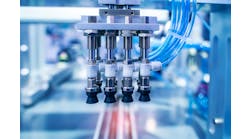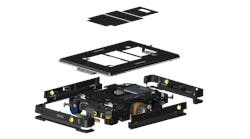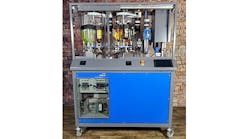Dr. Arne Linder is product manager, drives and controls, at Kollmorgen. Chris Radley is senior manager, global platform commercialization, at Kollmorgen.
What are three key things that a machine builder, system integrator or manufacturer should know about your company?
Chris Radley, senior manager, global platform commercialization, Kollmorgen: Experience, breadth of solution, and a track record of success. For more than 100 years, Kollmorgen has developed innovative machine automation and motion control solutions for our customers—from creating custom traction motors for NASA’s Mars Rover to traverse the Martian landscape to developing a thruster motor solution for Jason Jr. to work at depths of more than 3,800 meters (12,500 ft) exploring the wreck of the Titanic. When the first implantable artificial heart was invented, medical designers came to Kollmorgen to design the critical pumping motor. Every day, Kollmorgen helps machine builders, system integrators and manufacturers with solutions from the ordinary to the extraordinary.
Kollmorgen’s extensive breadth of product solutions means most applications can be optimized with a standard catalog product. When the customer needs something a little different, we co-engineer a solution. We can modify a design to meet the customer’s specific needs and then produce the product on our standard factory production lines to save costs, maintain rapid and reliable delivery, and give the customer assurance that this is a proven design. When something completely unique is required, Kollmorgen has a demonstrated track record of creating ground-up solutions that meet the most demanding requirements—from medical to robotics to aerospace/defense and automated guided vehicles (AGVs).
Kollmorgen never just settles for the good-enough solution; we take pride in being able to offer customers the right solution. We don’t force the customer to take what we already have; we deliver what they need. Having an extensive tool kit allows Kollmorgen to offer a control solution integrated in the drive for one design and then offer a stand-alone control for another. Whether it’s a frameless part set to build into a machine, a linear motor rather than a rotary motor with a gearbox, or connectivity to EtherCAT, Ethernet/IP or Profinet, Kollmorgen works to provide the customer with what is needed to succeed. And, while we have an extensive customer support organization, Kollmorgen emphasizes engineer-to-engineer conversations. The machine builder, system integrator or manufacturer engineers are encouraged to talk directly to Kollmorgen product design engineers, which often leads to the near-impossible becoming possible.
What new technologies are driving your product development and why?
Chris Radley, senior manager, global platform commercialization, Kollmorgen: The continuing advancements in electronics, software, networking, electromagnetic design and material sciences continually drive our product development. For example, to drive the AKD2G servo drive products, Kollmorgen developed Servo on a Chip: a powerful compute engine that can control two axes simultaneously and up to 28 I/O. The AKM2G servo-motor products leverage the latest advancements in electromagnetics and materials to provide significant torque increases in the same motor size. This allows OEMs and users to achieve substantial machine performance increases without increasing the size of the motor. Additionally, the improved torque density allows the use of a smaller motor to reduce the machine footprint without sacrificing performance. As a system, the 2G products benefit from motors and drives where the power, feedback and brake connection are combined in a single high-quality cable to reduce cable installation complexity and cost. The 2G Motion System also supports advanced features for functional safety both on the drive and in the motor. Advanced networking capabilities, including FailSafe over EtherCAT (FSoE) and a powerful easy-to-use graphical user interface (GUI) are a direct result of advancements in both hardware and software.
Constant product development that exploits the latest technologies is driven by customer need for machines to continually advance in speed, throughput, flexibility and precision in a smaller footprint to reduce user space requirements and be more energy efficient. Machines must provide better functional safety to keep them operational (functional) and protect the operators (safety).
Machines need to operate as standalone islands of automation—be smart on their own—or network into the total factory environment. All of this points to the need for easy-to-use, sophisticated motion capability that is not constrained to a proprietary solution that won’t work with other supplier products.
How does the Industrial Internet of Things figure in your business strategy?
Dr. Arne Linder, product manager, drives and controls, Kollmorgen: Kollmorgen offers the complete drive system—controller, drive and motor—so IIoT is clearly an important topic. The key element of IIoT is Internet access to everything, which means that each single sensor in the machine would be connected to the Internet, with worldwide access. Even though that clearly has some benefit, massive measures would need to be put in place by the machine builder to protect the production process from espionage or hacking attacks. It makes sense to have a dedicated communication path for the sensor information, which, in our case, is to provide the access to data such as motor speed and temperature, via the drive. In turn, the drive transmits the required information to the machine controller or PLC through industrial Ethernet or Fieldbus.
The impact of IIoT will be much bigger for the OEM vs. the motion-control supplier. We are already seeing trending away from selling a machine to lending the machine with the end user paying based on production throughput. IIoT is enabling the trend of changing from one-time-pay to a recurring payment and is continuing to increase in popularity through additional advances. IIoT technologies allow the OEM to precisely monitor machine usage and to bill the customer based on that usage. As a motion expert, Kollmorgen offers solutions to the OEM to measure machine productivity through Kollmorgen motors, drives and controllers.
How will machine automation and controls alter the way companies staff their operations in the future?
Chris Radley, senior manager, global platform commercialization, Kollmorgen: The increasing use of software-based control systems, device resident control systems—smart devices such as servo drives that can be the machine controller, direct-drive rotary and linear motors that replace traditional gearing and mechanical transmissions, networked communications and functional safety—will increasingly drive the way companies look at engineering and support staffs. While some exceptionally large companies might choose to add dedicated expert personnel in these areas, most will not. Instead, the existing personnel will be required to improve their knowledge in these areas. This can be a major challenge to balance their current workloads with the need to constantly increase productivity. Some may elect to outsource this to system integrators or, as we have seen at Kollmorgen, to look to suppliers to become partners in the design process. Engineer-to-engineer conversations are where we help the customer with challenges critical to success, but that are not the core competency of the business. The customer’s support staff will face similar challenges and will want to see that they are partnered with an organization that has the local, national and global reach and expertise to help them with any encountered operational machine issues.
How is the development of software solutions impacting your requirements for hardware?
Dr. Arne Linder, product manager, drives and controls, Kollmorgen: Twenty years ago, microcontrollers and memory chips were quite expensive. Additional drive software or firmware requirements with higher processing power quickly led to significant increase in costs. Software had to be written in assembler language to save calculation time. Today, the price for computational power has significantly dropped, leading to sophisticated control algorithms implemented on drive processor hardware. The more we increase software capability and dependence, the greater the power we require from the processors. Additionally, today’s networks are operating orders of magnitude faster than before.
In a recent example, I reviewed a system executing a program at 1 millisecond network speed to one executing the same program at 250 microseconds. The system executing at 1 ms operated comfortably at about 30% processor load. Increasing the network speed to 250 microseconds pushed the processor load to about 85%, near the point where communication errors might occur. Fortunately, the cost of processing power has decreased so that a simple shift to a faster processor on the controller easily brought the system load back in line, while permitting the much higher performance execution speed. It is now possible to use software in roles that were once only reserved for hardware. Using a software virtual axis in a multi-axis master-slave system can eliminate the lag that can occur between a hardware master and its slaves. The former hardware master, along with the slave axes, now see the program command via the virtual master at the same time, eliminating the lag.
Finally, with continual advancements, designer’s need to consider the costs of new designs. New technologies should be considered for new ground-up machine designs and incremental improvements, such as a change to a newer motor but not to change the drive, and to fully support the machine’s intended life.
As engineering and IT continue their convergence, which one is and/or will be leading the direction of future automation and technology at your organization?
Dr. Arne Linder, product manager, drives and controls, Kollmorgen: One main reason for the success of Kollmorgen is our extensive experience in motion control. We are sure that, especially through the growing implementation of IIoT, topics such as data security and protection will become more and more important, while the success of a motion-control company will be decided upon its motion experience. Consider the Kano Model of customer satisfaction—the functionality delivered by IT takes on a “must-be” quality, which is taken for granted. If you do not fulfill those demands in some way, then you will lose consideration. However, performance characteristics that differentiate you from the competition is considered a “one dimensional quality” attribute. To expand on this thought, let’s look at the decision process when buying a car. Although you would never buy a car without locks, you do not decide which car to buy based on the locking system; it must just be good enough to feel safe and so that the car cannot be easily stolen. You select the car based on other important requirements, such as driving performance.
It is similar with a motion-control system. Compare the data security and other IT topics in a motion-control system to the locking system of your car. While the OEM expects the system to be IT-wise secure, the decision is based on performance features that depend on design engineering skills. As IT developments become more important in motion-control development, engineering will continue to play a dominant role.
Looking into the future, how will technology change your company over the next five years?
Dr. Arne Linder, product manager, drives and controls, Kollmorgen: Technology changes will have different effects based on the department, but in all cases the main trend is towards digitalization.
Also read: CAD software draws on the concept of innovation
In manufacturing and logistics, there will be a trend of manual-labor reduction in favor of automation and robotics for repetitive manufacturing procedures. As increasing functional safety becomes a future requirement, there will be more changes than just the features and functions in products. There will be an obvious need for the ability and resources of supplier partners such as Kollmorgen to work with machine builders, system integrators and manufacturers to understand their choices and implementations. The complex, expensive and time-consuming process of certifying the design, manufacture and support will create significant operational demands. This includes the product functional safety features and mechanisms for notifying customers if recalls are required, which includes sourced component parts. This will challenge all companies, particularly smaller suppliers that lack the size and global reach of a company such as Kollmorgen. Additionally, Kollmorgen’s history of business process systems, defined by today’s Altra Business System that guides us in managing complex processes, will further challenge companies that lack this capability.
Research and development will be undergoing changes, as well. Since the functionality of the product is based more and more on software/firmware, software development skills will become more important. Hardware development will also be influenced by the digital world. Expensive laboratory product testing will be replaced by modeling and simulations in the future, which leads to cost savings and shorter development times.
The sales and marketing departments are often missed when discussing the impacts of technology changes. Classic marketing tools such as exhibitions, printed brochures and catalogues will be replaced by digital counterparts. This trend has clearly accelerated during the COVID-19 pandemic when exhibitions were canceled and sales teams did not visit customers in person. Virtual sales visits have rapidly gained importance, and, while in person meetings at customer sites will still exist, a new wave of digital connectiveness will become mainstream.





